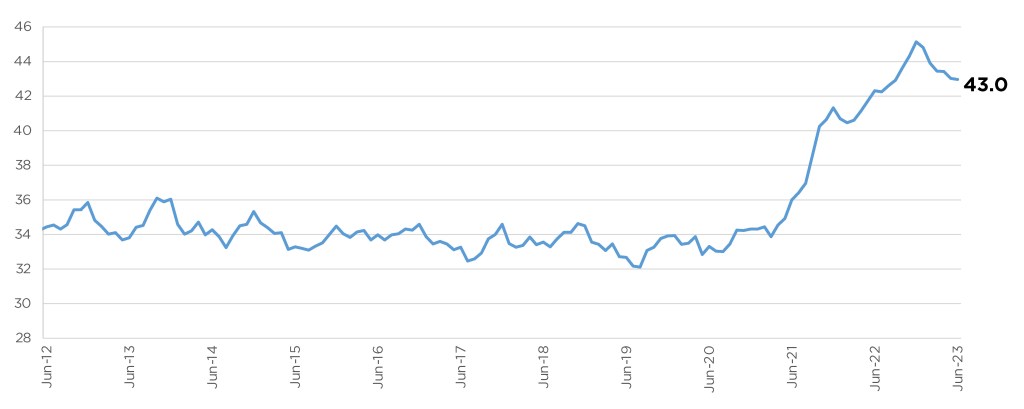Data Point
New-Vehicle Affordability Stable in June
Friday July 14, 2023
New-vehicle affordability was unchanged in June, according to the Cox Automotive/Moody’s Analytics Vehicle Affordability Index. Strong income growth helped to offset higher prices and slightly higher rates. Higher prices and rates caused the typical payment to increase somewhat from May, which was the lowest payment since October. The number of median weeks of income needed to purchase the average new vehicle in June was steady at 43.0 weeks from an upwardly revised 43.0 weeks in May, which had been the lowest level since September.
Cox Automotive/Moody’s Analytics Vehicle Affordability Index
June 2023
Weeks of Income Needed to Purchase a New Light Vehicle

“We came into this year with affordability at an all-time low due to record prices, interest rates approaching 20-year highs, and tighter credit conditions,” Cox Automotive Chief Economist Jonathan Smoke said. “At mid-year, I believe we can definitively say at least things did not get worse.”
Estimated Typical New Car Monthly Payment at $771
The median income grew 0.3%, and incentives from manufacturers increased, and both of those moves helped consumers with affordability. The average new-vehicle transaction price increased 0.3% in June, according to Kelley Blue Book. The typical new-vehicle loan interest rate increased by 4 basis points to 9.63%1. As a result of these changes, the estimated typical monthly payment increased by 0.2% to $771 from an upwardly revised $770 in May. The average monthly payment peaked at $795 in December.
New-vehicle affordability in June only changed modestly compared to a year ago when prices and interest rates were on the rise. The estimated number of weeks of median income needed to purchase the average new vehicle in June was up 1.5% from last year.
“Looking at the macroeconomic factors that affect vehicle affordability, we could indeed see consumer auto loan rates improve even if the Fed has a move or two left,” Smoke noted. “So, I think we have threaded that needle. If we see more supply bring more discounting and incentives in the new-vehicle market and used cars are depreciating, it means affordability won’t get worse from here.”
Click here for the full methodology for the Cox Automotive/Moody’s Analytics Vehicle Affordability Index.
The next update of the Cox Automotive/Moody’s Analytics Vehicle Affordability Index will be published on Aug. 15, 2023.
1 The index input of the average interest rate paid by consumers is calculated to reflect a 72-month, fixed-rate loan. For the Dealertrack estimated, volume-weighted average new loan rate in June, visit the Auto Market Snapshot.
The Cox Automotive/Moody’s Analytics Vehicle Affordability Index (VAI) is updated monthly using the latest data from government and industry sources, including key pricing data from Kelley Blue Book, a Cox Automotive company. This important industry measure will be released at mid-month to indicate if the prices paid for new vehicles are moving out of consumers’ financial reach or becoming more affordable over time.
